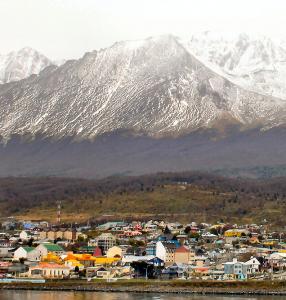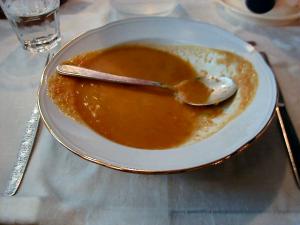"What? You've been to the South Pole?"
Unfortunately I haven't, but this question is frequently asked when someone looks at a map showing my various journeys. I have, however, done something that surprisingly few seem able to tell apart from a visit to the actual South Pole. I visited the Antarctic Peninsula, the thin finger of land stretching up from Antarctica towards South America.
All that separates the two continents is an inch or so of water, on a typical globe. In real life, this inch consists of an astounding number of actual inches; as you try to cross it by boat, this becomes disturbingly evident.

 The bottom of the world
The bottom of the world
On a backpacker trip through South America, I eventually reached Ushuaia. It's the southern-most town in Argentina, yet it looks just like the coastal village in northern Norway where I spent my childhood. The harbour is full of fishing boats. From a distance the small and cozy homes look like a quilt of many colours. Surrounding the town inland is a wreath of dramatic mountains with snow and ice on top of them, and to the south of the island, a mighty ocean lurks.
It's easy to spend a few days in and around Ushuaia. Hike in the mountains or walk along the Beagle Channel. Feel the history of the island Tierra del Fuego, Fireland, and imagine what it was like to arrive there for the first global circumnavigators, not that long ago, really. You can catch sizable salmon in the rivers, visit an Argentinian estancia/ranch, or you can explore the streets in the town at the end of the world. Or "The bottom of the world", as they somewhat unfortunately tend to call it. Round off your days at a restaurant, enjoying passionate tango and the largest, most tender steaks in the world.
The greatest thing to do in Ushuaia though, is to get on a boat and cross the Southern Seas to reach Antarctica. How far south you go depends on which vessel you travel in and when you go. A number of large cruise ships do Antarctica trips from Ushuaia, but for safety reasons, they stay clear of the ice. Hence they usually only visit islands, not the actual Antarctic mainland. On the other side of the scale, you can go with robust, Russian icebreakers. At the end of the summer they easily make their way well past the Antarctic Circle at roughly 66.5 degrees south.
In Ushuaia I was lucky to be offered an inexpensive last minute ticket to Antarctica. I was to travel with M/V Mariya Yermalova, a fairly basic Russian ship with a strengthened hull, designed to handle iceberg encounters reasonably well. It was the perfect size, with room for about a hundred passengers. IAATO, the International Association of Antarctica Tour Operators, regulates Antarctic tourism. A rule is that no vessel can put more than a hundred people on shore simultaneously. This way the penguins will always outnumber the people on any beach, which is good. More importantly, this meant I would get a lot of time on land.
A crew of fifty and the ship's doctor spoke Russian fluently. In English, however, all they could say was "I hope no problem". Fortunately we also had twelve English-speaking experts on polar matters on board, ready to tell us everything we needed to know.
Among the passengers there were also many interesting personalities. Unique destinations tend to attract unique people. The variety was still large, with more than twenty different nationalities represented. They spanned from the filthy rich with insanely expensive cameras and clothes, to backpackers wearing the same rags they had started out with thousands of miles away. One of them asked whether there was a discount if he slept in the lifeboats instead of a cabin. Slightly worrying, the purser told him, "That will cost extra". I hoped it was a joke.
Our journey began with a lifeboat practice and a wonderful dinner, before we started getting to know each other. Many of us were excited and maybe even a little bit tense, as we knew so little about what was in store for us. The Japanese crowd immediately started writing postcards, while the Israelis mysteriously disappeared. Maybe they went below deck to search for their Promised Cabin. I stayed up for a while, but when the captain turned up in the bar with a wide smile on his face, I decided to go to bed.
While the ship had seemed to be the perfect size, in theory, I wished for a bigger boat when we reached the open sea. The stretch of water between the continents is officially called the Drake Passage, after English privateer Sir Francis Drake (who never actually went there). When you're there, though, you'll just know it as the Drake Shake.
When I went to sleep, we were still close to land, the water was calm. I fell asleep to the sound of creaking boards and orders to the crew being barked over the intercom, in Russian. It was like being in a James Bond movie. I slipped into a dream full of dangerous missions and incredibly friendly females in various supporting roles.
At four in the morning someone violently shook me out of sleep. But I was alone in my bed. More specifically, there were definitely no bikini-clad supermodels around. I realized that we had reached the open sea. A seasickness pill brought me back to slumber.
At six I woke up again. The until then silent Japanese in the upper bunk crashed onto the floor like a kamikaze sleepwalker. He landed on all the stuff that had been on our bedside stands the evening before. "I am trouble!", he groaned, and bravely climbed up into his bed again.

 Soup plate overload
Soup plate overload
At 7:30 I did not have breakfast. Others tried, but gave up when milk, coffee and cereal floated around on the floor to the degree that people started getting wet feet. Some managed to make their way back to their beds, while others could not do anything but lie down where they were. Lunch later in the day consisted of tomato soup served in cups. The waves now made soup plates useless. How they even managed to make the soup is something I can only speculate about.
Throughout the day lectures were given to a tiny audience. What impressed the attendees the most was not the quality of the presentations, but that the lecturers managed to remain standing while they spoke. "Bring a pillow, a cover and a seasickness bag, come and learn about the albatross", the loudspeakers enthused. I now slept on the floor.
For two days we struggled across the ocean, making around eight knots on average. When you have a thousand kilometres of mayhem to cover, that is depressingly slow. I stayed in bed, which turned out to be just my size. I could "stand" steadily on the lower end of the bed while using my hands to hold onto the bedposts on each side of my head. This way I avoided being slung out of bed as the ship was thrown this way and that by giant waves. This effort demanded enough of my concentration to allow me to forget seasickness.
It was still slightly discomforting, especially when the room maids visited. Obviously more used to life at sea than me, they did some dusting and tidying up, looked at me and said "Zorry to yoo". I was sort of fascinated by the situation. Trapped in my bed I could do nothing but listen to the stream of messages to the crew. I understood parts of what was said. One of the messages was "Zbigniew machinistr *mumble mumble* schdavodch KAPUT!", and there was some frantic discussion going on in the background.
I had been puzzled by something a polar explorer said in an interview she gave before one of her trips to Antarctica. When asked about what she dreaded the most about the strenuous expedition ahead of her, she answered, "The boat ride home, of course".
Now I understand.
For more on the author and his experiences in Antarctica, check out this link.